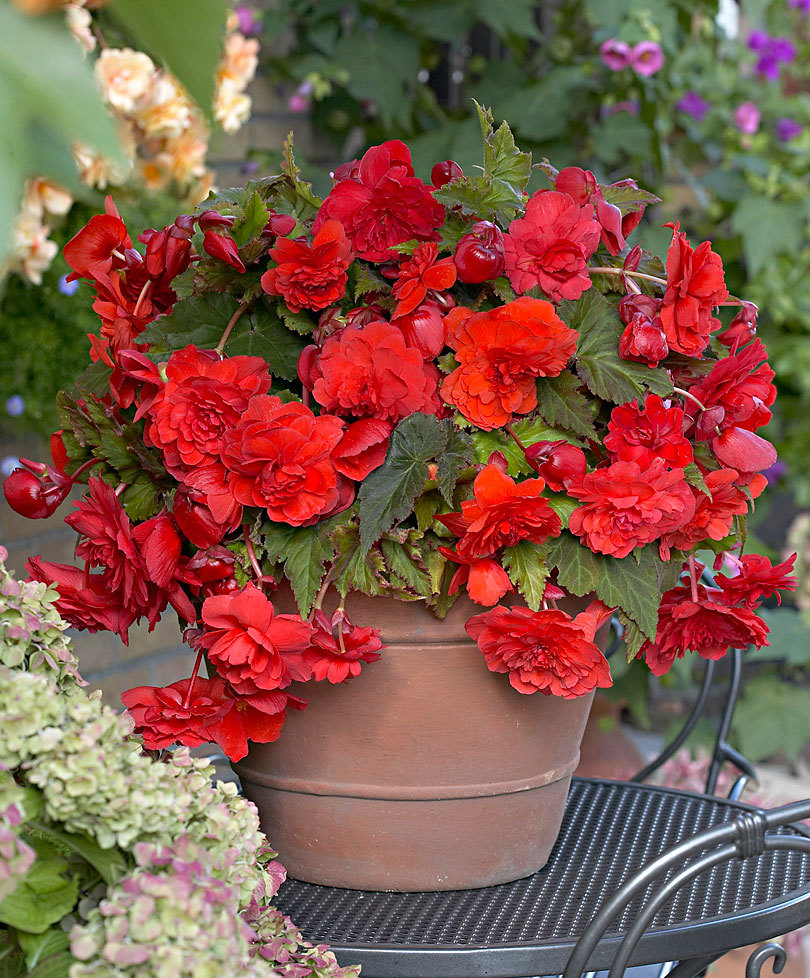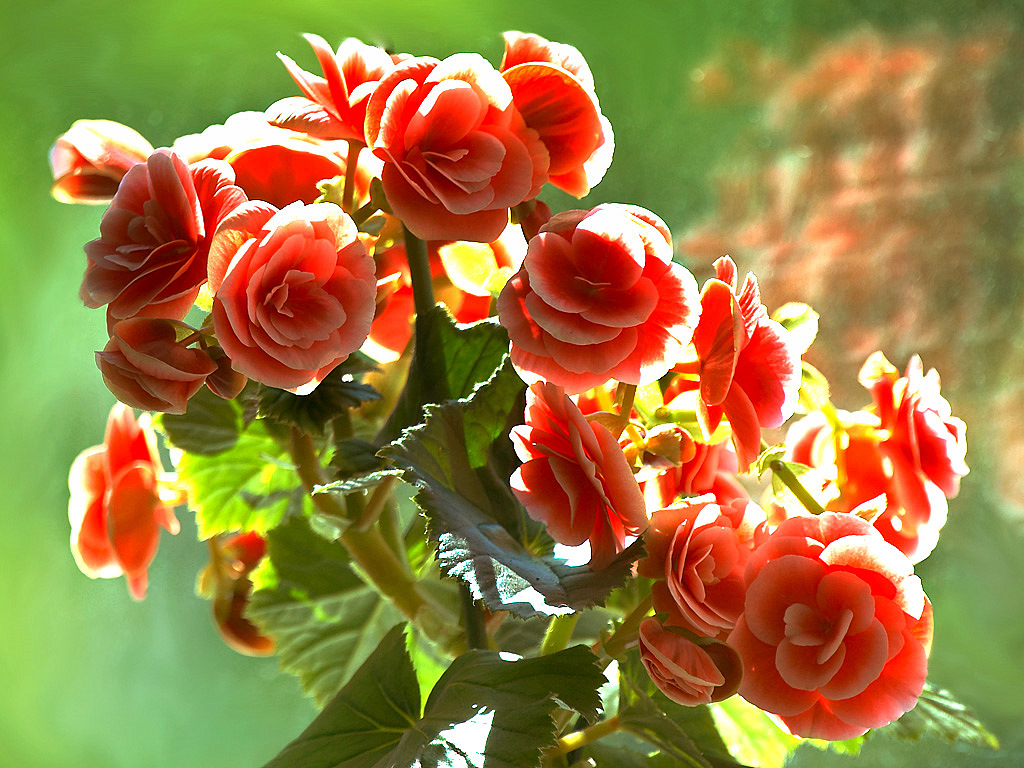Begonia can be found not only on windowsills, but also in parks and flower beds. Bright and fun colors helped her to gain popularity. It got its name from the surname of Michel Begon, who at the end of the 17th century discovered an unknown flower in the Antilles and described it.
Today, the natural habitat of the plant is America, Asia and Africa, but you can grow it at home in almost any part of the world.
Content
Overview of begonias
Begonia flower is an annual or perennial shrub or semi-shrub. The shrub can reach 2 meters in height and small - about 1−2 cm - flowers. Tuberous variants produce flowers up to 30 cm in diameter. Useful properties include:
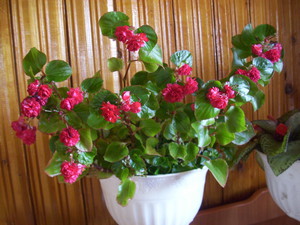 Active absorption of harmful chemicals, due to which the air in the room is quickly cleaned.
Active absorption of harmful chemicals, due to which the air in the room is quickly cleaned.- Air humidification.
- Elimination of electromagnetic radiation.
- Contains a significant amount of useful substances (organic acids and tannins), which have antiallergic and antiseptic properties, and therefore can be used in folk medicine.
Beneficial features:
- Increased immunity in people living in the apartment.
- Recovery of working capacity and elimination of the feeling of fatigue.
- Decreases nervous tension.
Feng Shui adherents also believe that the plant helps to smooth out conflicts, elimination of negative energy, normalization of the biofield and increasing self-confidence at a subconscious level.
Begonia is divided into a thousand different species, not to mention two thousand hybrids. Basically, species are divided into the following categories:
- flowering: flowers are the main ones;
- decorative deciduous: they are grown for the sake of beautiful greenery.
Reproduction methods
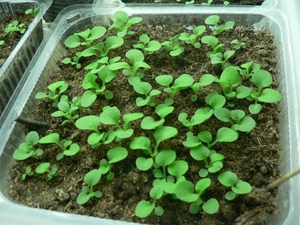 Homes are usually grown perpetually and decoratively flowering varieties. There are two ways to propagate a plant.
Homes are usually grown perpetually and decoratively flowering varieties. There are two ways to propagate a plant.
Seed propagation... They are planted in February using one part of peat and sand and two parts of leaf land. The pot is covered with a transparent lid and left in a warm room. Watering is carried out by the drip method.
The first shoots appear in a week. When they get stronger, they begin to slowly adapt to room conditions. After another two weeks, the sprouts can be planted, but very carefully: they are still fragile and die easily. After a month, the begonia can be finally transplanted to the chosen place.
Tuber propagation method... Sprouted tubers, you need to put them on a damp cloth and wait until the roots appear. Then they can be transplanted into the ground, but do not bury too deep: the tuber should protrude from the ground by 1-2 cm when it gets warm, the plant is planted in an open flower garden.
Features of flower care
Basic rules for good growth and flowering:
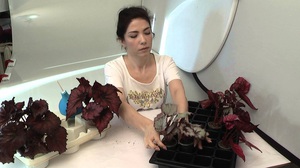 Begonia grows and develops best in warmth: not lower than +18 degrees in winter and +20 degrees in summer.
Begonia grows and develops best in warmth: not lower than +18 degrees in winter and +20 degrees in summer.- She loves light, but poorly tolerates direct rays, so it is better not to leave her for a long time in the sun.
- It requires frequent watering, but it is necessary to observe the measure, do not overmoisten the soil and try not to fall on the leaves. It does not need to be sprayed at all: this can lead to the appearance of spots on the leaves. It is better to leave a container of water next to it to maintain optimal humidity.
- Separately, it should be noted that the plant does not like permutations. It is better not to move it unnecessarily and not touch the leaves with your hands.
- Care is simple: just trim dry leaves. Some cultivars need to have their tops trimmed so that they develop sideways.
- During the growth period, you can additionally fertilize with minerals.
- The main diseases are: powdery mildew, rot, bacterial spotting. Among the pests, aphids, spider mites, weevils, caterpillars, thrips and worms are distinguished.
Main types
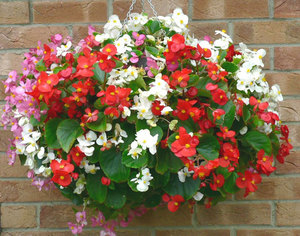 Despite the abundance of options, several types stand out among the domestic ones. They have some characteristics of care and cultivation.
Despite the abundance of options, several types stand out among the domestic ones. They have some characteristics of care and cultivation.
Eternal blooming... Among the variety of species, the graceful begonia, Lanchiana and Schmidt are especially popular. They have wide smooth leaves and small flowers of white, red or pink shades. They grow up to 50 cm.
For optimal development, it is necessary to observe an increased daylight hours - at least 16-18 hours. Special phytolamps can help. The temperature should be at least +20 degrees. To immerse the flower in hibernation, it is enough to lower the temperature to +15 degrees. Twice a month it is necessary to make a bait with boron and manganese.
Tiger... It does not grow above 30 cm, which is very convenient at home. Blooms usually in winter. Small flowers are white or pinkish, leaves are small, serrated at the edges, bright green with a brown border and light spots.
Leaving is no different from the usual. Some growers prefer to remove flowers, as they have practically no aesthetic value.
Griffin (royal grade). A subspecies of royal begonia. Its distinguishing feature is the carved edge of large leaves, which have a double color: dark green and pink, slightly pearlescent.
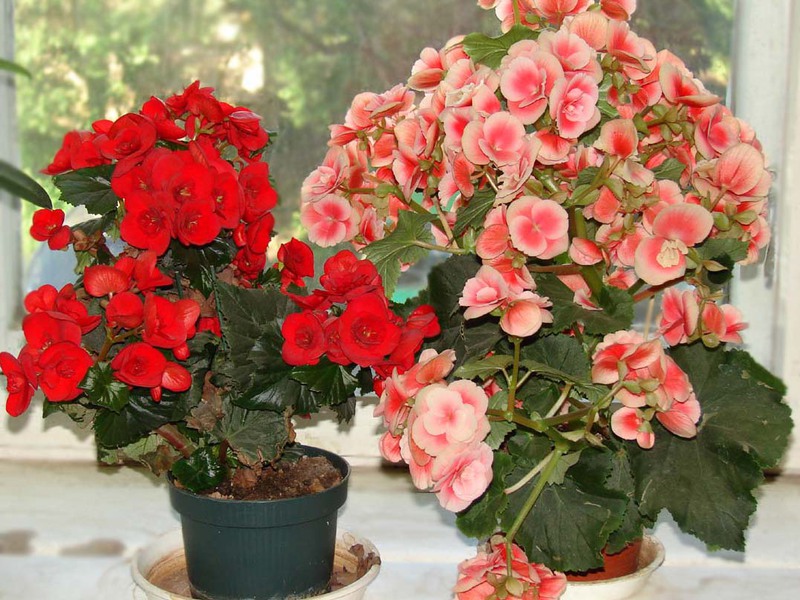
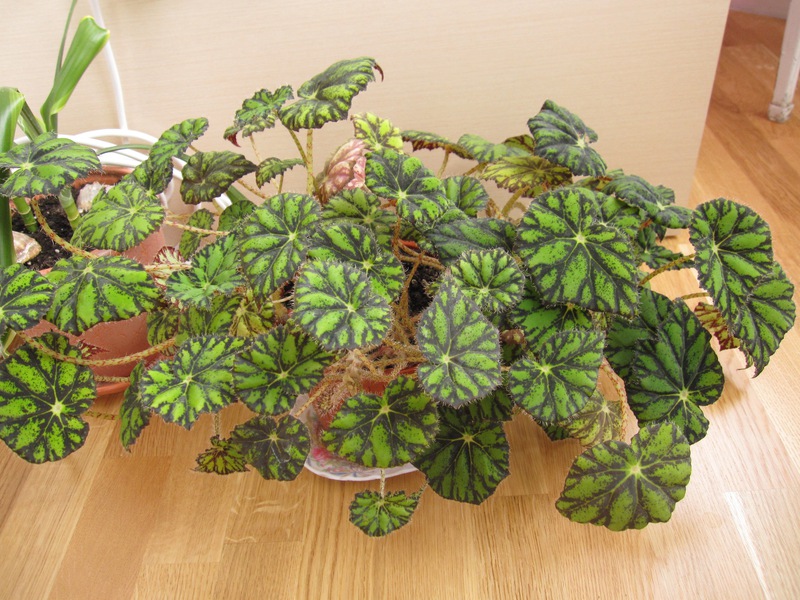
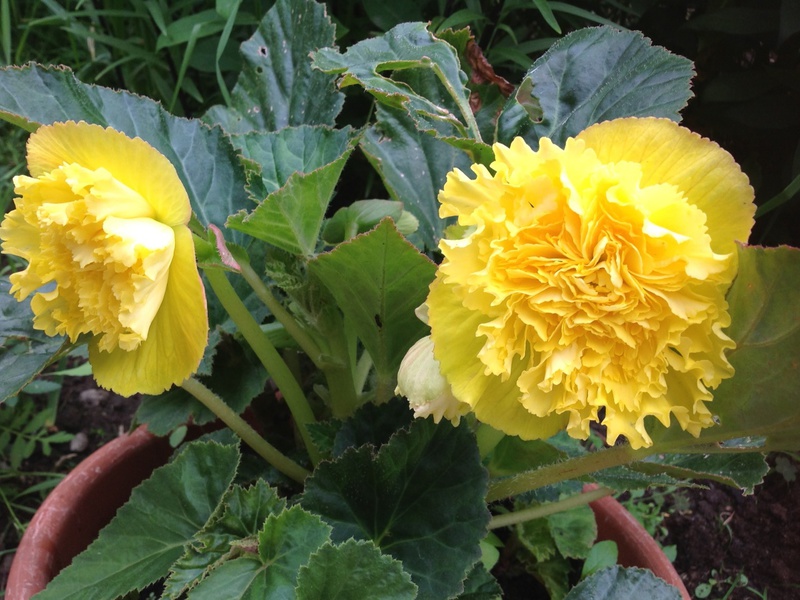

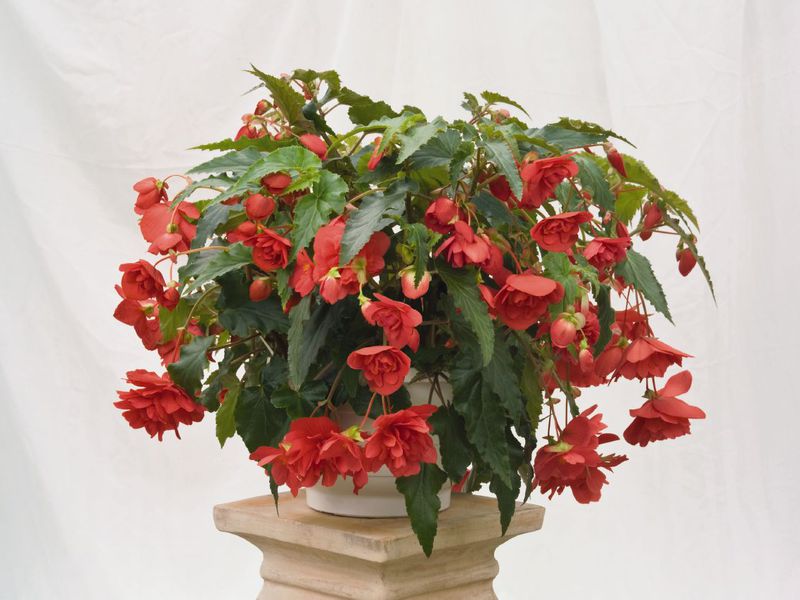
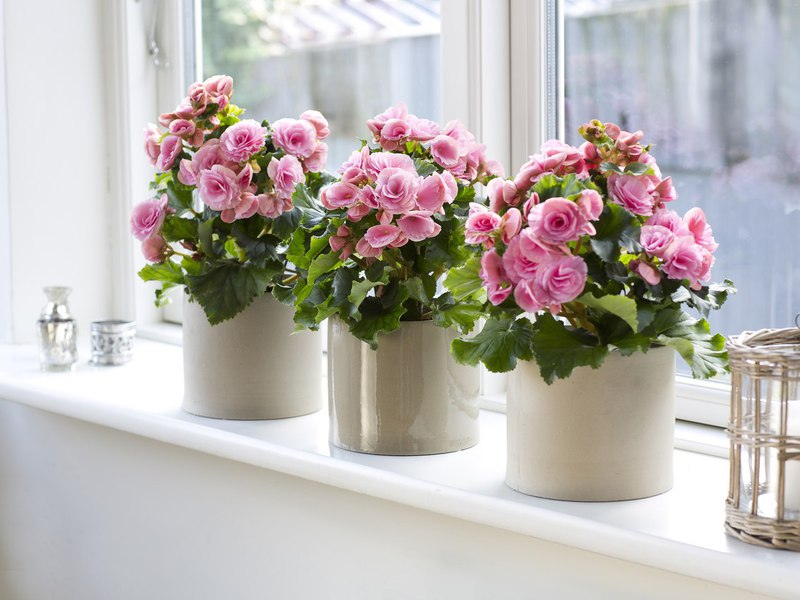
Yellow... The species is divided into subspecies - double and non-double, there is also a semi-double variety. Color options are also varied: pink, white, red, yellow with a pink border.
Reaches a height of 40−45 cm, has recumbent shoots. Leaves are oval, with denticles at the edges. The outer side of them is smooth, has a green color, inside it is burgundy with fluff.
Red-leaved... The name comes from the color of the inside of the sheet. The leaves reach 15 cm, the stem is short, light green. It blooms with small pinkish flowers from December to June. With proper care, a bushy plant is obtained.
Metal... The name comes from the leaves: the outside is light green with red veins and a metallic sheen. It can grow up to 90 cm.
It is unpretentious in care: moderate humidity and watering, no spraying. It is recommended to plant in acidic soil and periodically turn in different directions towards the sun to form a beautiful bush.
Varieties of begonias that require special care
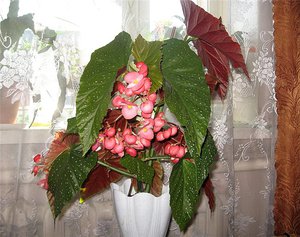 Coral... It has two varieties: with pink flowers and red-orange. The height is 30−90 cm, the leaves are silvery with green veins, the lower part is red. The lifespan is about 5 years, propagated by cuttings. Requires regular pruning, otherwise it may grow too large. Looks best in hanging pots.
Coral... It has two varieties: with pink flowers and red-orange. The height is 30−90 cm, the leaves are silvery with green veins, the lower part is red. The lifespan is about 5 years, propagated by cuttings. Requires regular pruning, otherwise it may grow too large. Looks best in hanging pots.
Begonia royal or Rex... It features large leaves with jagged edges and an interesting pattern: it seems to consist of multi-colored specks. As in the above species, the flowers are small and faded, usually cut off immediately after emergence.
Royal begonia requires moderate humidity and a darkened area, does not tolerate dry air and moisture on the leaves.
Ampelnaya... It is also called dangling because of the shoots: they are thin and form a beautiful "waterfall", therefore it is better to plant it in a flowerpot.It blooms from early spring to late autumn. The flowers are small, up to 5 cm, the color is bright: burgundy, orange, red.
Despite the fact that the flowers dry up after 10 days, new ones immediately grow in their place. It requires good lighting and heat, withstands up to +25 degrees. It is recommended to feed with minerals during flowering, nitrogenous fertilizers in the spring and organic fertilizers in the summer (no more than twice a season). The most famous variety is Pendula begonia.
Cleopatra... Due to the shape of the leaves, it received the name American Maple. Outside, they are olive green, on the back side they are covered with white hairs.
The stem is erect, grows up to 35 cm. Does not tolerate excessive watering and dry air. For even development, it is necessary to turn the bush regularly so that all sides receive light.
Types of begonias for beginner florists
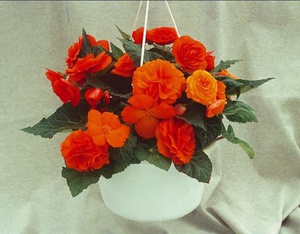 Elatior or winter... The compact plant reaches a height of 40 cm, the heart-shaped leaves are small, up to 8 cm, with a smooth succulent surface. The flowers are also small, no more than 5 cm, usually pink.
Elatior or winter... The compact plant reaches a height of 40 cm, the heart-shaped leaves are small, up to 8 cm, with a smooth succulent surface. The flowers are also small, no more than 5 cm, usually pink.
Flowering usually occurs in the winter, however, after the appearance of the leaves, all decorativeness is lost, and begonia requires rejuvenation.
For abundant flowering, it is necessary to gradually reduce the daylight hours to 9 hours (the usual one should be more than 16 hours), then cover with a dark film. This will help you get more flowers and cycle faster. Otherwise, Elatior does not differ from general advice.
Non-stop... This is an annual plant, not exceeding 20 cm in height. Moreover, it is quite bright: the flowers reach almost 10 cm in diameter, the leaves are bright green. It blooms from June until the first frost. Feeding is required twice a month.
Bauer... The view is perfect for novice florists: it is not demanding and at the same time beautiful. It has large decorative leaves that should not be left in the sun, otherwise stains will appear.
Watering is moderate, the temperature should be at least +16 degrees. The dwarf Bauer variety grows only up to 10 cm, but produces white and pinkish flowers.
Despite some difficulties in care, begonia is quite simple and undemanding. In addition, she will surely repay with the beauty of the leaves and bright flowers, which will surely cheer everyone up.
